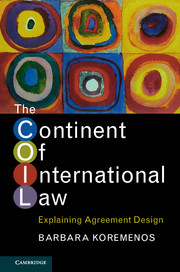Book contents
- Frontmatter
- Dedication
- Contents
- List of figures
- List of tables
- Acknowledgments
- 1 (Re)discovering the continent
- Part I COIL's building blocks: theory and data
- Part II Flexibility provisions in the design of international law
- 4 Duration provisions
- 5 Escape clauses and withdrawal clauses
- 6 (Im)precision and reservations
- Part III Centralization, scope, and control provisions in the design of international law
- Appendix 1 List of agreements in COIL sample
- Appendix 2 Coding rules
- Appendix 3 Selection issues in international cooperation data sets
- References
- Index
5 - Escape clauses and withdrawal clauses
from Part II - Flexibility provisions in the design of international law
Published online by Cambridge University Press: 05 June 2016
- Frontmatter
- Dedication
- Contents
- List of figures
- List of tables
- Acknowledgments
- 1 (Re)discovering the continent
- Part I COIL's building blocks: theory and data
- Part II Flexibility provisions in the design of international law
- 4 Duration provisions
- 5 Escape clauses and withdrawal clauses
- 6 (Im)precision and reservations
- Part III Centralization, scope, and control provisions in the design of international law
- Appendix 1 List of agreements in COIL sample
- Appendix 2 Coding rules
- Appendix 3 Selection issues in international cooperation data sets
- References
- Index
Summary
The function of a system of international relationships is not to inhibit this process of change by imposing a legal straitjacket upon it but rather to facilitate it: to ease its transitions, to temper the asperities to which it often leads, to isolate and moderate the conflicts to which it gives rise, and to see that these conflicts do not assume forms too unsettling for international life in general. But this is a task for diplomacy, in the most old-fashioned sense of the term. For this, law is too abstract, too inflexible, too hard to adjust to the demands of the unpredictable and the unexpected. (Emphases mine.)
(George Kennan 1951: 95)In the COIL sample, 19 percent of agreements have escape clauses and 70 percent of agreements have withdrawal provisions. When we layer this type of flexibility on top of the finite duration and renegotiation provisions discussed in Chapter 4, international law does not appear to impose the “legal straitjacket” George Kennan ascribes to it. Quite the contrary, the escape clauses discussed and analyzed in this chapter are incorporated precisely “to temper the asperities” of the tumultuous world of international politics, and the withdrawal clauses also discussed and analyzed in this chapter allow states “to adjust to the demands” of the completely “unpredictable and the unexpected.” Especially noteworthy is the fact that only 13 agreements in the COIL sample (around 6 percent of the sample) have neither escape clauses nor withdrawal provisions nor a limited duration.
Still, while the detailed flexibility provisions of international law allow rather than inhibit change, these same provisions are also designed to help the agreements themselves serve as stable equilibrium outcomes. Put differently, these provisions are not the “softening” mechanisms that Guzman (2008) labels them to be; rather, these provisions themselves are quite nuanced to prevent opportunistic behavior. In fact, the sub-clauses of such flexibility provisions ensure that the provisions are not used in ways that disrupt the cooperative equilibrium states achieved in the first place through international law. The analyses of variation in such subtleties – such as whether approval is needed to utilize an escape clause and the notice period in withdrawal clauses – buttress one of the overall arguments of this book: Nuanced design provisions are a necessary condition for international law to be an equilibrium institution.
- Type
- Chapter
- Information
- The Continent of International LawExplaining Agreement Design, pp. 124 - 157Publisher: Cambridge University PressPrint publication year: 2016



